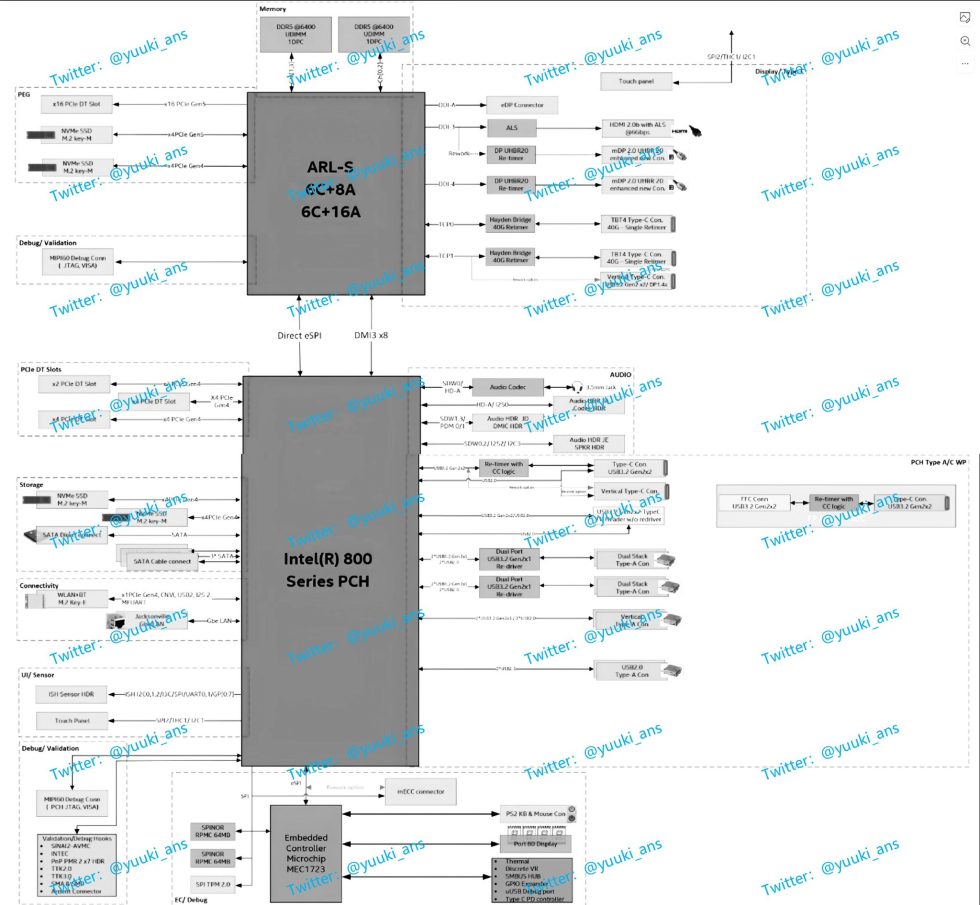YuuKi_AnS has released the latest internal documents on the upcoming Arrow Lake-S desktop CPU platform, resulting in a new platform leak. Although a lot of information about the Intel Arrow Lake CPUs is already known, we now get a more detailed insight into the upcoming features of the platform.
The upcoming Intel Arrow Lake-S desktop CPUs will be based on the Lion Cove P-Core and Skymont E-Core architectures. They will have up to 8 P-Cores and 16 E-Cores, which corresponds to a total of 24 cores and 32 threads – similar to the current flagship CPUs of the 14th and 13th generation. The chips will have up to 125W PL1 TDPs and a maximum base clock frequency of 3.5 GHz (pre-alpha state). In addition, the CPUs will receive the latest GT1 Xe-LPG iGPU, but with reduced Xe cores compared to those used in the Meteor Lake CPUs. Interestingly, Intel separately mentions 8 IA cores with 8 threads, which are stated to be disabled in the 125W variant.

According to a previously leaked slide, the Intel Arrow Lake-S desktop CPUs offer a 5% IPC boost and a 15% increase in multi-core performance. There is also talk of the new P-Cores & E-Cores, which are already based on the Lion Cove and Skymont architectures. The CPUs are also said to have an up to 50% larger L2 cache.
- Arrow Lake-S (Lion Cove P-Core) – 3 MB L2 cache per core
- Raptor Lake-S (Raptor Cove P-Core) – 2 MB L2 cache per core
- Alder Lake-S (Golden Cove P-Core) – 1.25 MB L2 Cache Per Core
The presentation material refers to the family as the 15th generation, suggesting that it is either outdated or the company is still using the older branding for the desktop family. The Intel laptop CPUs have introduced a new Core Ultra & Core series, which has led to a reboot of the branding to 1st Gen. The Arrow Lake-S CPUs are also listed as pre-alpha state and have issues in the BIOS that are rumored to be fixed in a future stepping.

In terms of platform, Intel will be offering Arrow Lake-S desktop CPUs on its brand new LGA 1851 socket motherboards with the 800-series PCH. This offering includes the Z890, H870, B860 and H810 series. The high-end motherboards will support up to DDR5-6400 memory. The platform diagram also shows two other SKUs with 6 8 and 6 16 configurations.
- Arrow Lake-S 8 16 (24 cores / 32 threads)
- Arrow Lake-S 6 16 (22 cores / 28 threads)
- Arrow Lake-S 6 8 (14 cores / 20 threads)
The future desktop platform will offer native support for significantly higher memory clock speeds, with up to 6400 MT/s in a dual-channel configuration. The processors will also support native x16 PCIe Gen5 dGPU and x4 PCIe Gen5 M.2 lanes, as well as additional x4 Gen4 PCIe lanes for M.2. A detailed breakdown of CPU and PCH I/O reveals the following:
Arrow Lake-S CPU:
- DDR5 UDIMM/SODIMM – 6400 MT/s Native
- 1×4 eDP 1.4
- DP2.0 UHBR20/HDMI 2.1
- 2x USB 4.0 TBT4/DP
- 2.0/HDMI 2.1 Type-C
- 24 total PCIe lanes
- 20 PCIe Gen5 lanes (1×16 1×4)
- 4 PCIe Gen5 lanes (1×4)
- 8 SATA III lanes
MTL-S/ARL-S PCH For 800-Series Motherboards:
- DMI Gen4 1×8
- 24 Total PCIe Gen4 Lanes
- 6 x4 Controller (Max)
- 14 Root Port (Max)
- 8 SATA III lanes
- 3x GbE ports
- 10 USB 3.2 Gen2 x1 ports (two ports can be used as a single USB Gen 3.2 Gen2x2 port, maximum 4 supported)
- 14 USB 2.0 ports
- 802.11ax R2 w/TDBC (160 80), BT6/WIFI7
- 1x CSME SPI
- 2 x TCH SPI

Intel Arrow Lake-S desktop CPUs will be part of the next generation LGA-1851 socket, which will be introduced on 800 series motherboards and will offer the following features:
- LGA 1851 socket with planned lifespan through 2026
- DDR5 compatibility only, no support for DDR4
- Starts with 800 series motherboards
- Support for up to DDR5-6400 memory (Native JEDEC)
- Increased PCIe Gen 5.0 lanes over CPU & PCH
- Arrow Lake-S first desktop family to be supported
- Arrow Lake-S CPUs have 3 MB L2 cache per P-Core
- Arrow Lake-S CPUs have updated Alchemist iGPUs
- Arrow Lake-S CPUs have integrated LLC “Adamantine” for GPU tile
- Arrow Lake-S CPUs offer 8 16, 8 0, 6 8 CPU SKUs
- Launch in the 2nd half of 2024
Intel’s Arrow Lake-S desktop processors are positioned for launch on gaming platforms such as desktop PCs later this year. They will compete with AMD’s Zen 5-based Ryzen “Granite Ridge” CPUs, which are also in production and expected to launch in H2 2024. Stay tuned for further updates and information.
Source: YuuKi_AnS































10 Antworten
Kommentar
Lade neue Kommentare
Urgestein
Urgestein
Veteran
Urgestein
Veteran
Mitglied
Mitglied
Urgestein
Veteran
Alle Kommentare lesen unter igor´sLAB Community →